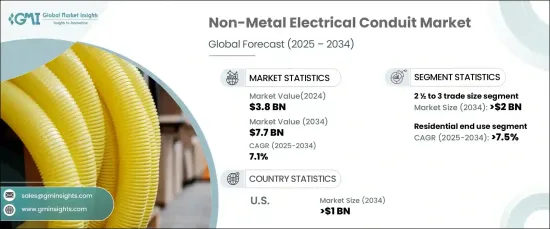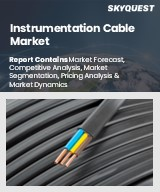
|
시장보고서
상품코드
1666566
비금속 전선관 시장 : 기회, 성장 촉진요인, 산업 동향 분석 및 예측(2025-2034년)Non-Metal Electrical Conduit Market Opportunity, Growth Drivers, Industry Trend Analysis, and Forecast 2025 - 2034 |
||||||
세계의 비금속 전선관 시장은 2024년 38억 달러에 달했으며, 2025년부터 2034년까지 연평균 성장율 7.1%의 강력한 성장세를 보일 것으로 전망됩니다.
이러한 급증은 주로 건설 활동의 증가, 급속한 도시화, 보다 안전하고 비용 효율적인 전기 시스템에 대한 수요 증가에 기인합니다. 도시가 확장되고 인프라 개발이 가속화됨에 따라 안정적인 전기 시스템에 대한 필요성이 커지면서 시장 확대에 더욱 박차를 가하고 있습니다. 특히 태양광 발전과 같은 재생 에너지 프로젝트는 비금속 전기 전선관에 대한 수요를 증가시키고 있습니다. 또한 전기 안전을 둘러싼 엄격한 규제으로 인해 고품질 전선관 솔루션에 대한 규제 준수 중심의 수요로 인해 시장이 수혜를 받고 있습니다.

이 시장에서 가장 주목할 만한 트렌드 중 하나는 비금속 전선관의 지속적인 혁신입니다. 제조업체들은 난연성이 우수하고 내구성이 강화되며 환경 스트레스에 대한 저항성이 향상된 제품을 개발하는 데 주력하고 있습니다. 이러한 혁신은 주거용, 상업용 및 산업용 전반에 걸쳐 보다 효율적이고 오래 지속되는 전기 시스템에 대한 증가하는 수요를 충족합니다. 원자재 가격의 변동과 기존 금속 전선관 공급업체와의 치열한 경쟁이 문제가 될 수 있지만, 비금속 전선관은 경제성, 설치 용이성, 안전 기능으로 인해 여전히 선호되는 선택입니다.
| 시장 범위 | |
|---|---|
| 시작 연도 | 2024년 |
| 예측 연도 | 2025-2034년 |
| 시작 금액 | 38억 달러 |
| 예측 금액 | 77억 달러 |
| CAGR | 7.1% |
2 1/2-3인치 사이즈의 비금속 전선관은 2034년까지 20억 달러의 매출을 창출할 것으로 예상됩니다. 이러한 수요 증가는 복잡한 전기 설비를 더 잘 보호할 수 있는 더 큰 전선관 크기에 대한 필요성이 커지고 있기 때문입니다. 특히 비금속 전선관은 여러 케이블을 효율적으로 수용하는 동시에 뛰어난 보호 기능을 제공하기 때문에 복잡한 인프라 프로젝트에 이상적이라는 점에서 선호도가 높습니다. 또한 건설 업계가 보다 에너지 효율적이고 지속 가능한 건축 관행을 수용함에 따라 비금속 전선관에 대한 수요도 계속 증가하고 있습니다.
주거 부문은 비금속 전선관 시장에서 가장 높은 성장을 보일 것으로 예상되며, 2034년까지 7.5%의 연평균 성장률을 기록할 것으로 전망됩니다. 이러한 급증은 특히 신규 건설 프로젝트에서 전기 안전에 대한 관심이 높아지고 재생 에너지 시스템에 대한 관심이 증가함에 따라 이루어지고 있습니다. 비금속 전선관은 비용 효율적이고 가벼워 주거용에 이상적인 선택입니다. 건물 안전과 에너지 효율적 관행을 장려하는 정부 규제 또한 비금속 전선관이 지속 가능성 목표에 부합하는 설치하기 쉬운 솔루션을 제공하므로 수요를 강화합니다.
미국의 비금속 전선관 시장은 2034년까지 10억 달러에 달할 것으로 예상됩니다. 이러한 성장은 견고한 건설 부문, 에너지 효율적인 건물로의 전환 증가, 전기 안전에 대한 강조 증가에 기인합니다. 또한 재생 에너지 부문, 특히 태양광 발전이 시장 성장에 크게 기여하고 있습니다. 비금속 전선관은 실외 배선 시스템을 보호하는 데 널리 사용되므로 태양광 발전 설비에 필수적입니다. 안전과 지속 가능성을 우선시하는 정부 규제과 건축 법규는 전국적으로 이러한 전선관에 대한 수요를 지속적으로 뒷받침하고 있습니다.
목차
제1장 조사 방법과 조사 범위
- 시장의 정의
- 기본 추정과 계산
- 예측 계산
- 데이터 출처
- 1차
- 2차
- 유상
- 공개
제2장 주요 요약
제3장 업계 인사이트
- 업계 생태계 분석
- 규제 상황
- 업계에 미치는 영향요인
- 성장 촉진요인
- 업계의 잠재적 위험 및 과제
- 성장 가능성 분석
- Porter's Five Forces 분석
- 공급기업의 협상력
- 구매자의 협상력
- 신규 참가업체의 위협
- 대체품의 위협
- PESTEL 분석
제4장 경쟁 구도
- 전략 대시보드
- 혁신과 지속가능성의 전망
제5장 시장 규모와 예측 : 호칭 지름별(2021-2034년)
- 주요 동향
- 1/2-1
- 1 1/4-2
- 2 1/2-3
- 3-4
- 5-6
- 기타
제6장 시장 규모와 예측 : 분류별(2021-2034년)
- 주요 동향
- 폴리염화비닐(PVC)
- 강화 열경화성 수지(RTRC/FRE)
- 경질 비금속(RNC)
- 전기 비금속 튜브(ENT)
제7장 시장 규모와 예측 : 최종 용도별(2021-2034년)
- 주요 동향
- 주거용
- 상업용
- 산업용
- 유틸리티
제8장 시장 규모와 예측 : 지역별(2021-2034년)
- 주요 동향
- 북미
- 미국
- 캐나다
- 멕시코
- 유럽
- 프랑스
- 독일
- 이탈리아
- 영국
- 러시아
- 아시아태평양
- 중국
- 인도
- 일본
- 한국
- 호주
- 중동 및 아프리카
- 사우디아라비아
- 아랍에미리트(UAE)
- 카타르
- 남아프리카
- 라틴아메리카
- 브라질
- 아르헨티나
제9장 기업 프로파일
- ABB
- Anamet Electrical
- Astral
- Atkore
- Cantex
- Champion Fiberglass
- Electri-Flex
- 광동 Ctube Industry
- HellermannTyton
- Hubbell
- Legrand
- Schneider Electric
- Wienerberger
The Global Non-Metal Electrical Conduit Market reached USD 3.8 billion in 2024 and is poised to experience robust growth at a CAGR of 7.1% between 2025 and 2034. This surge is mainly driven by an uptick in construction activities, rapid urbanization, and a rising demand for safer, more cost-effective electrical systems. As cities expand and infrastructure development accelerates, the need for reliable electrical systems is growing, further fueling the market's expansion. Renewable energy projects, especially solar power, are adding to the demand for non-metal electrical conduits. Additionally, with stringent regulations surrounding electrical safety, the market is benefiting from a wave of compliance-driven demand for high-quality conduit solutions.

One of the most notable trends in this market is the continuous innovation of non-metal conduits. Manufacturers are focusing on developing products with superior flame-retardant properties, added durability, and enhanced resistance to environmental stress. These innovations cater to the growing need for more efficient, long-lasting electrical systems across residential, commercial, and industrial applications. While fluctuations in raw material prices and strong competition from traditional metal conduit suppliers may pose challenges, non-metallic conduits remain a preferred choice due to their affordability, ease of installation, and safety features.
| Market Scope | |
|---|---|
| Start Year | 2024 |
| Forecast Year | 2025-2034 |
| Start Value | $3.8 Billion |
| Forecast Value | $7.7 Billion |
| CAGR | 7.1% |
The segment of non-metal electrical conduits with trade sizes between 2 1/2 and 3 inches is expected to generate USD 2 billion in revenue by 2034. This increase in demand is attributed to the growing need for larger conduit sizes that offer more protection for complex electrical installations. Non-metallic conduits are particularly favored for their ability to house multiple cables efficiently while providing superior protection, making them ideal for complex infrastructure projects. Additionally, as the construction industry embraces more energy-efficient and sustainable building practices, demand for non-metallic conduits continues to rise.
The residential sector is expected to see the highest growth in the non-metal electrical conduit market, with a projected CAGR of 7.5% through 2034. This surge is driven by an increasing focus on electrical safety, particularly in new construction projects, as well as a growing interest in renewable energy systems. Non-metallic conduits are cost-effective and lightweight, making them an ideal choice for residential applications. Government regulations promoting building safety and energy-efficient practices also bolster demand, as non-metallic conduits provide an easy-to-install solution that aligns with sustainability goals.
The U.S. non-metal electrical conduit market is expected to reach USD 1 billion by 2034. The growth is attributed to a robust construction sector, an increasing shift toward energy-efficient buildings, and a growing emphasis on electrical safety. Additionally, the renewable energy sector, especially solar power, is contributing significantly to market growth. Non-metallic conduits are widely used to protect wiring systems outdoors, making them essential in solar power installations. Government regulations and building codes that prioritize safety and sustainability continue to support the demand for these conduits across the country.
Table of Contents
Chapter 1 Methodology & Scope
- 1.1 Market definitions
- 1.2 Base estimates & calculations
- 1.3 Forecast calculation
- 1.4 Data sources
- 1.4.1 Primary
- 1.4.2 Secondary
- 1.4.2.1 Paid
- 1.4.2.2 Public
Chapter 2 Executive Summary
- 2.1 Industry synopsis, 2021 - 2034
Chapter 3 Industry Insights
- 3.1 Industry ecosystem analysis
- 3.2 Regulatory landscape
- 3.3 Industry impact forces
- 3.3.1 Growth drivers
- 3.3.2 Industry pitfalls & challenges
- 3.4 Growth potential analysis
- 3.5 Porter's analysis
- 3.5.1 Bargaining power of suppliers
- 3.5.2 Bargaining power of buyers
- 3.5.3 Threat of new entrants
- 3.5.4 Threat of substitutes
- 3.6 PESTEL analysis
Chapter 4 Competitive Landscape, 2024
- 4.1 Strategic dashboard
- 4.2 Innovation & sustainability landscape
Chapter 5 Market Size and Forecast, By Trade Size, 2021 – 2034 (USD Million)
- 5.1 Key trends
- 5.2 ½ to 1
- 5.3 1 ¼ to 2
- 5.4 2 ½ to 3
- 5.5 3 to 4
- 5.6 5 to 6
- 5.7 Others
Chapter 6 Market Size and Forecast, By Classification, 2021 – 2034 (USD Million)
- 6.1 Key trends
- 6.2 Polyvinyl Chloride (PVC)
- 6.3 Reinforced Thermosetting Resin (RTRC/FRE)
- 6.4 Rigid Non-Metallic (RNC)
- 6.5 Electrical Non-Metallic Tubing (ENT)
Chapter 7 Market Size and Forecast, By End Use, 2021 – 2034 (USD Million)
- 7.1 Key trends
- 7.2 Residential
- 7.3 Commercial
- 7.4 Industrial
- 7.5 Utility
Chapter 8 Market Size and Forecast, By Region, 2021 – 2034 (USD Million)
- 8.1 Key trends
- 8.2 North America
- 8.2.1 U.S.
- 8.2.2 Canada
- 8.2.3 Mexico
- 8.3 Europe
- 8.3.1 France
- 8.3.2 Germany
- 8.3.3 Italy
- 8.3.4 UK
- 8.3.5 Russia
- 8.4 Asia Pacific
- 8.4.1 China
- 8.4.2 India
- 8.4.3 Japan
- 8.4.4 South Korea
- 8.4.5 Australia
- 8.5 Middle East & Africa
- 8.5.1 Saudi Arabia
- 8.5.2 UAE
- 8.5.3 Qatar
- 8.5.4 South Africa
- 8.6 Latin America
- 8.6.1 Brazil
- 8.6.2 Argentina
Chapter 9 Company Profiles
- 9.1 ABB
- 9.2 Anamet Electrical
- 9.3 Astral
- 9.4 Atkore
- 9.5 Cantex
- 9.6 Champion Fiberglass
- 9.7 Electri-Flex
- 9.8 Guangdong Ctube Industry
- 9.9 HellermannTyton
- 9.10 Hubbell
- 9.11 Legrand
- 9.12 Schneider Electric
- 9.13 Wienerberger



















